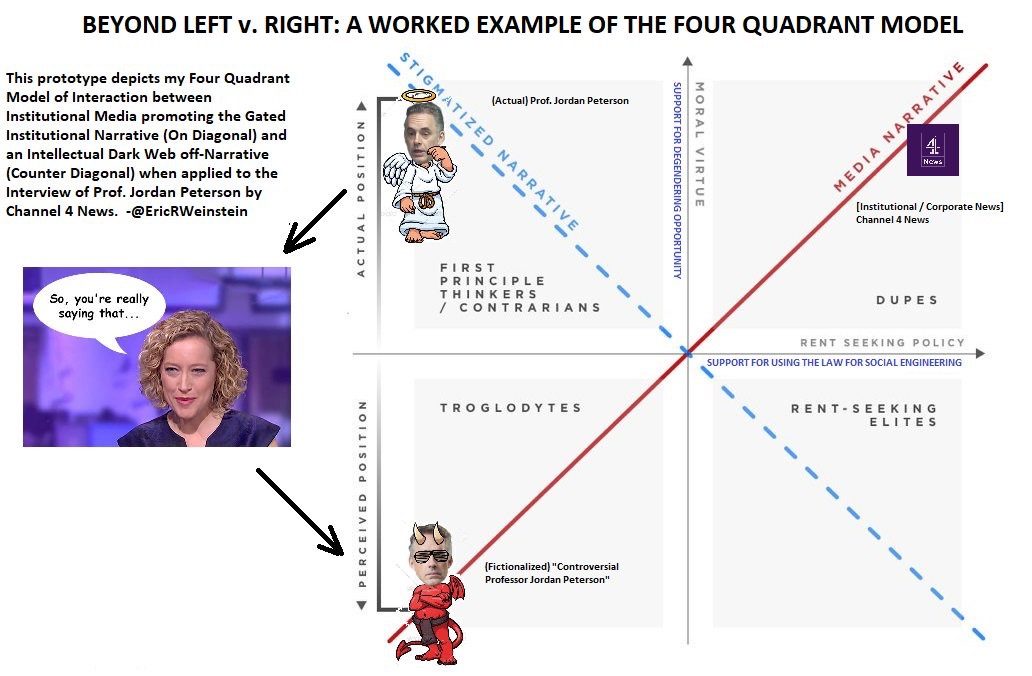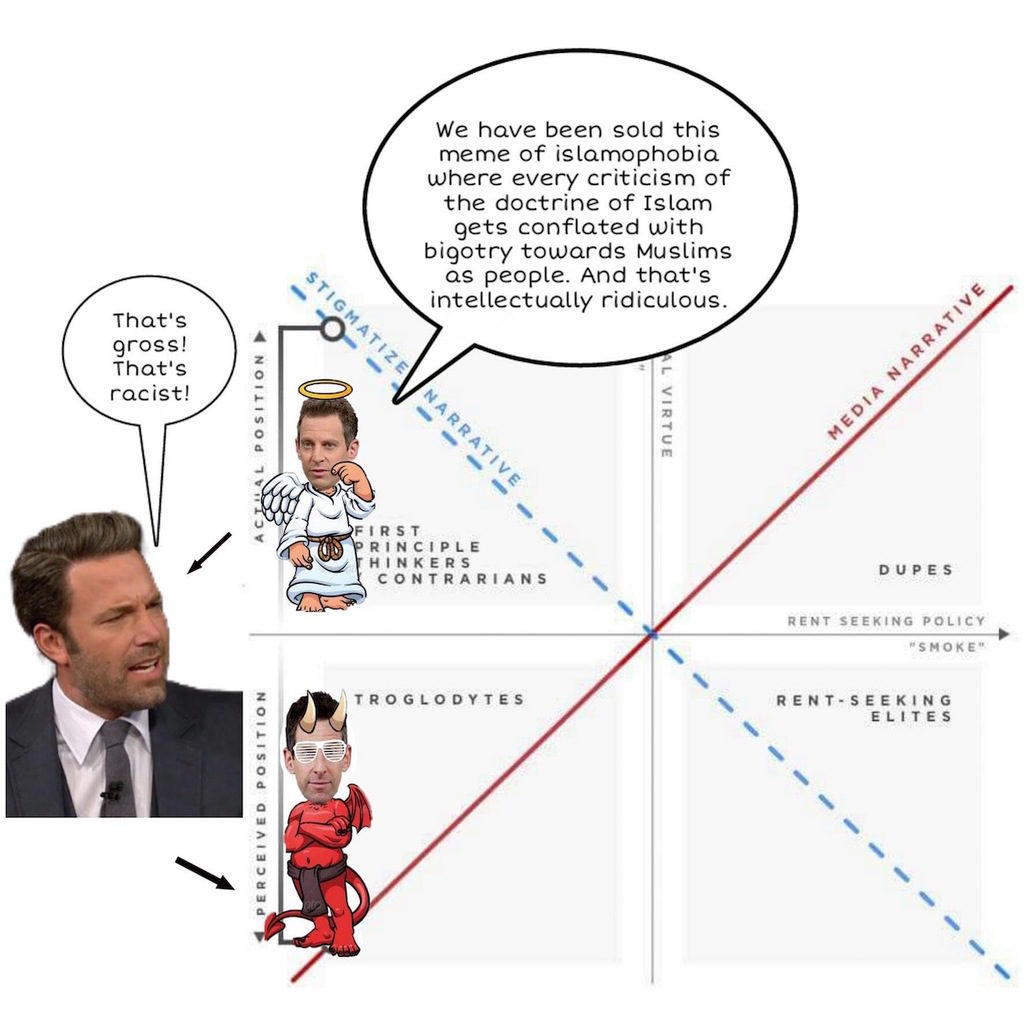In broad terms, the model is a tool for illustrating how the media stigmatizes certain nuanced views that challenge the status quo by portraying people who hold those views as prejudiced or intolerant. Let's start with a simplified version of the model:
The horizontal line (or x-axis in mathematical terms) represents one's level of support for a particular policy initiative. For example, in the interview, Cathy Newman advocated mandating equality of outcome, or the idea that men and women ought to have approximately the same level of income regardless of individual differences. Newman would fall on the right-hand side, which denotes support for this policy (positive x-value) and Peterson would be on the left side, which represents anyone who disagrees with or is critical the policy (negative x-value).
The vertical line (y-axis) represents some kind of moral virtue, which in this case would be equality of opportunity, or the fair treatment of people as opposed to discriminating based on age, race, gender or sexual orientation (we'll focus on gender for now). Those in the top half (positive y-value) oppose discrimination and those in bottom half (negative y-value) are prejudiced against people (women in this case) based on gender.
These two axes create four quadrants. Starting in the top right and moving counterclockwise, they are:
- The "Dupes": People who believe they can infer someone's true intentions, beliefs or morality based on their support for, or opposition to, the policy initiative (more on this later).
- "First principle thinkers" or "contrarians": They hold nuanced positions that oppose the policy on the x-axis, but support the moral virtue on the y-axis. In an interview with Dave Rubin, Weinstein said, "These are people who are thinking for themselves, and are not buying baked-cakes. They're buying the ingredients and they're saying, well, I want more of this ingredient, I don't like that ingredient. So they're attempting to avoid having any pre-baked idea put in front of them."
- "Troglodytes": Those who oppose the x-axis policy and possess the moral vice represented by the lower-half of the y-axis (e.g. prejudice against women). For example, a true troglodyte in the Peterson-Newman interview might have said women are inferior to men and thus deserve less pay.
- "Rent seekers": People or companies who have a vested-interest in the x-axis policy because they profit from it, but do not produce much or anything of value in return.
Now that we know what the axes and quadrants represent, let's see how the model illustrates the dynamic that played out between Newman and Peterson:
- Peterson, who is in the "First principle thinkers" quadrant, gives a nuanced argument that is opposed to mandated equality of outcome (e.g. mandated income-equality between men and women), but that supports equality of opportunity (e.g. opposed to discrimination based on gender).
- Newman is in the "Dupes" quadrant. She infers that Peterson's opposition suggests he condones, or is at least unconcerned, with discrimination based on gender. For example, she said, "You're saying, basically, it doesn't matter if women aren't getting to the top."
- As a result, Peterson is portrayed as a misogynist, or insensitive to gender discrimination, effectively moving him from the "First principle thinkers" quadrant to the "Troglodyte" quadrant. However, this is counter to his actual position, which is support for equality of opportunity (and not discriminating based on age, race, gender or sexual orientation), which he said was "eminently desirable."
The "media narrative" can be shown on the graph as a straight line going from the bottom left to top right:
The media narrative is based on faulty reasoning. Just because someone is opposed to an equality of outcome initiative mandating that men and women get the same pay, doesn't necessarily mean they are prejudiced against women. It's possible to oppose gender discrimination and also question whether the discrepancy between incomes is solely due to gender, or also due to other factors.
Putting it all together
Here's an example of the complete diagram*, applied to the Peterson interview and recently tweeted by Weinstein:
*Note: The axes in this diagram are labeled differently from the diagrams above, but illustrate the same process.
Seeing the pattern
"The Four Quadrant Model of media narrative control has been the crown jewel in the toolbox I've personally used for unspinning the central Gated Institutional Narrative (or GIN) for years, but it was somehow too complicated to give to others until the Cathy Newman/Jordan Peterson and Ben Affleck/Sam Harris interactions resulted in a mass awakening," Weinstein said in an interview.
"Once the pattern is seen, however, it cannot be unseen, and realizing that you have been repeatedly controlled by a single trick tying your virtue to a thwarting of your own interests, is what is likely causing the model to spread more rapidly now," he said. "When people realize how they can oppose misstructured free trade without being protectionist, totalitarian Islam without being anti-Muslim, or oppose mass-immigration without being in any way xenophobic, the news media will no longer be able to play the role of Iago, playing its audience like unwitting pawns against each other in a deadly game of political chess for the quiet financial interests of a powerful few."
More examples
Peterson isn't the only person falsely portrayed as a "troglodyte" by the media narrative. Let's look at a few others.
Sam Harris
In 2014, neuroscientist and author Sam Harris debated Ben Affleck and others about radical Islam on the show Real Time with Bill Maher. During the debate, Harris challenged the notion that if someone criticizes certain aspects of Islam, they are prejudiced against Muslims as people. Affleck called Harris' views "gross" and "racist."
X-axis: Acceptance of all aspects and doctrines of Islam.
Y-axis: Tolerance for other religions (i.e. no prejudice)
Media narrative: Harris is Islamophobic because he's critical of radical Islam.
Catherine Deneuve
Earlier this month, French actress Catherine Deneuve, along with 99 other women, signed a public letter criticizing the #MeToo movement. Here are two excerpts from an English translation of the letter:
"The Harvey Weinstein scandal sparked a legitimate awakening about the sexual violence that women are subjected to, particularly in their professional lives, where some men abuse their power."
"#MeToo has led to a campaign ... of public accusations and indictments against individuals who, without being given a chance to respond or defend themselves, are put in the exact same category as sex offenders. This summary justice has already had its victims."
X-axis: Level of support for presumption of guilt, or "summary justice"
Y-axis: Level of support for protecting people from violence, abuse or exploitation.
Media narrative: If you aren't with the #MeToo movement, you're a victim blamer and a rape-apologist. In fact, some women called those who signed the letter "apologists for rape" and "defenders of paedophiles," according to The Guardian.
Bret Weinstein
In April 2017, Evergreen State College in Olympia, Washington, planned to hold its annual "Day of Absence," when some people of color would choose to not be present on campus in order to demonstrate the importance of their roles at the university. However, this time, the organizers of the event reversed the process, and white people were asked to absent themselves from the campus instead.
Bret Weinstein, who is Eric's brother and was a professor of biology at Evergreen, wrote an email challenging the change to the "Day of Absence," and there were student protests over it a few weeks later, according to an article he co-wrote with his wife in the Washington Examiner. Bret also wrote that he had previously been called a "racist" at faculty meetings for asking that the college's equity initiatives be thoroughly discussed. Bret has a history of opposing racism and in the article he and his wife described themselves as being "progressive-left."
X-axis: Support for Evergreen State College equity policies, specifically asking white people to leave the campus for "Day of Absence."
Y-axis: Opposition to racism
Media narrative: Because Bret opposed the changes to the "Day of Absence," he must be a racist.
Your turn
Now it's your turn to apply the model. Try it with Peter Thiel (who helped fund Terry Bollea's lawsuit against Gawker), Ayaan Hirsi Ali (who received death threats for criticizing how women are treated under fundamental Islamic law), James Damore (author of the controversial Google memo), or others who may be "first principle thinkers" branded as "troglodytes" for having views that don't fit the media narrative.









Comment: See also: